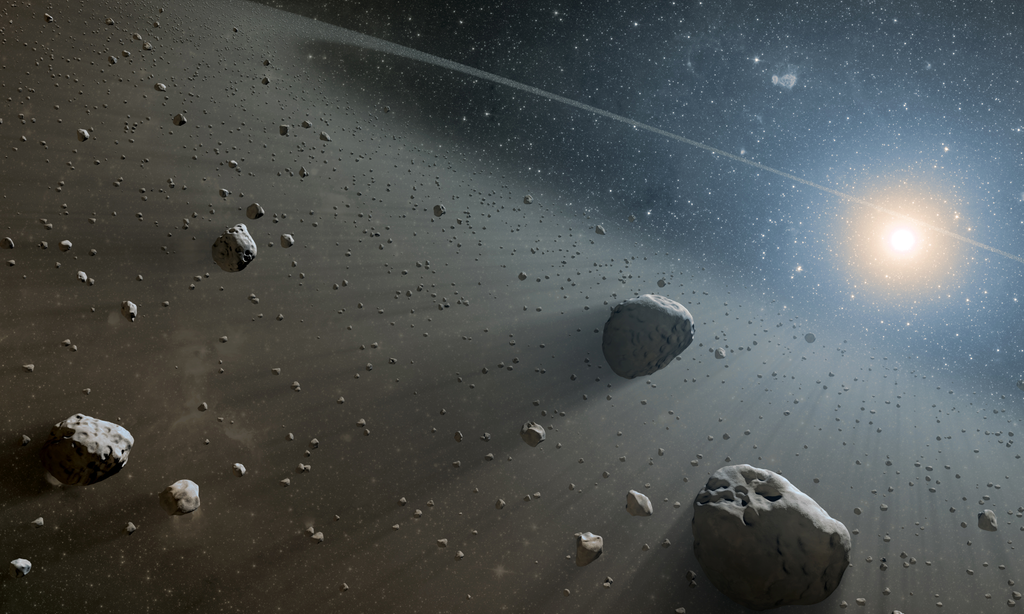The asteroid belt is slowly vanishing, shedding dust and rocks
The asteroid belt is slowly vanishing, shedding dust and rocks that still shape Earth and reveal our solar system’s history.

New research shows the asteroid belt is eroding faster than once thought. (CREDIT: Wikimedia / CC BY-SA 4.0)
Lying between Mars and Jupiter is a massive ring of rock debris—the asteroid belt. Now thin, it's fading away gradually. In a new study, planetary scientist Julio A. Fernández of Uruguay's Universidad de la República illustrates how quickly it's losing mass and what it means for Earth's long cosmic crash history.
A Quiet but Steady Disappearance
Fernández's research estimates the cost at about 8.8 × 10⁻⁵ of its own weight per million years, for the asteroid belt's most collision-prone region —the billions of small rocks still colliding with one another. That doesn't sound so bad, but over billions of years, all that loss adds up. About 20 percent of that mass is lost as large pieces of debris, and 80 percent is broken down into minuscule dust.
Most of this dust accumulates in the zodiacal cloud, a thin sun-scattering haze that clods the inner solar system. The same dust causes the dim glow you occasionally see at dawn or dusk, termed zodiacal light. Through the soft tug of light pressure, or Poynting–Robertson drag, these particles gradually are nudged toward the Sun. They are then trapped by the Earth's atmosphere as micrometeorites—small particles which collectively deliver thousands of tons of extraterrestrial material into our world annually.
The Role of the Giant Planets
Belt asteroids are not wandering aimlessly. Their fate is governed by powerful gravitational waves—regions where their paths intersect those of Jupiter, Saturn, or Mars. These invisible "riptides" will deflect asteroids from their stable paths, propelling some into the direction of Earth and others into Jupiter's domain.
When such objects find themselves in these exposed areas, they're typically expelled around the solar system. Some of them are captured into Earth-crossing orbits and eventually hit our planet as meteorites. Some others impact again within the belt, breaking up into minute pieces that recycle the process of grinding and scattering eternally. In the long run, this process provides both the constant drizzle of cosmic dust and the occasional fireworks meteor shower seen from Earth.
To assign a figure to how rapidly the belt is shedding mass, Fernández contrasted its current mass loss with simulations of earlier impact rates documented in lunar craters and Earth's oldest rocks. He discovered that around 3 to 3.5 billion years ago the belt was roughly 50 percent more massive and shedding mass twice as rapidly as it is now. In other words, the inner planets—including our own Earth—were getting hit more often then.
Even small changes to the rate of estimated depletion can radically redraw this picture. If the today loss rate were low by a factor of three, the original asteroid belt could have been exponentially larger—whereupon early solar system was very much denser and more collisional. That is the sort of case to fit evidence observed from the Late Heavy Bombardment, an interval with heavy cratering on the Moon and Mars.
The Unseen Strength of the Belt in Controlling Life
Such effects did not simply create the craters we see; they shaped life itself. Impacts likely delivered volatiles and organic chemicals necessary for life to early Earth—recipes that could have started biology. But the very same process has been devastating, too. The most famous impact, 66 million years ago, killed the dinosaurs and remade the planet's ecosystems.
With the belt of asteroids stripped, cataclysmic impacts are uncommon. The majority of space debris that currently strikes Earth is inert dust or small meteorites. However, even gradual depletion from the belt still provides a cosmic conveyor belt of material that reminds us, periodically, of the fragility of our own planet.
The Science of Space Dust and Meteorites
Approximately 80 percent of the lost material from the belt is in microscopic dust form according to Fernández, with the remaining portion incinerating as bulk fragments. Fragments that remain after surviving the pyroclastic free fall through the atmosphere of the Earth are meteorites—solid sample pieces of matter scientists analyze to understand the chemistry of the early solar system.
Following these meteorites to their parent bodies within the belt, scientists can view where areas are most active or unstable. Not only does that tell us about the evolution of the solar system, but it helps monitor potential impact dangers. The belt, though boring at a distance, is still speaking via the unloading of stones and cosmic dust.
While it appears serene, the asteroid belt is a fragile and volatile system held in balance by two opposing forces: collisions that shatter asteroids into dust and gravitational forces that push them out into space. Fernández contends that this equilibrium has reached a state of stable stability—one that will last for billions of years unless chaos on a colossial scale upsets it.
But even small variations in the orbits of Saturn and Jupiter would disrupt that balance. On the geologic timescale, those infinitesimally small differences could add up to increase the number of fragments heading toward the inner planets, leaving a new generation of craters as evidence of cosmic brutality.
Practical Implications of the Research
By knowing how the asteroid belt wears down, scientists are able to piece together the solar system's history and forecast how impacts in the future will be happening. It also makes more precise models of how planetary systems are formed throughout the rest of the galaxy.
For our world, this research does more than offer a peek at the past—it offers insight into our current understanding of space debris risk. In correlating dust formation, resonance phenomena, and meteorite genesis, Fernández's research provides researchers with means to determine how frequently our planet collides with new material from the belt.
With time, the asteroid belt is a cosmic hourglass gliding at glacial speeds. Symbolically and literally, its grains inscribe the age and history of the solar system, beginning with the oldest planetesimals that never formed into a planet and the meteorites that still impact our rooftops today.
Research findings are available online in the journal arXiv.
Related Stories
- Vesta might be much more than an asteroid, astronomers find
- NASA's Lucy prepares for second asteroid flyby on the road to Jupiter
- Astrophysicists find structure in 74 exocomet belts orbiting nearby stars
Like these kind of feel good stories? Get The Brighter Side of News' newsletter.
Joseph Shavit
Science News Writer, Editor-At-Large and Publisher
Joseph Shavit, based in Los Angeles, is a seasoned science journalist, editor and co-founder of The Brighter Side of News, where he transforms complex discoveries into clear, engaging stories for general readers. With experience at major media groups like Times Mirror and Tribune, he writes with both authority and curiosity. His work spans astronomy, physics, quantum mechanics, climate change, artificial intelligence, health, and medicine. Known for linking breakthroughs to real-world markets, he highlights how research transitions into products and industries that shape daily life.



